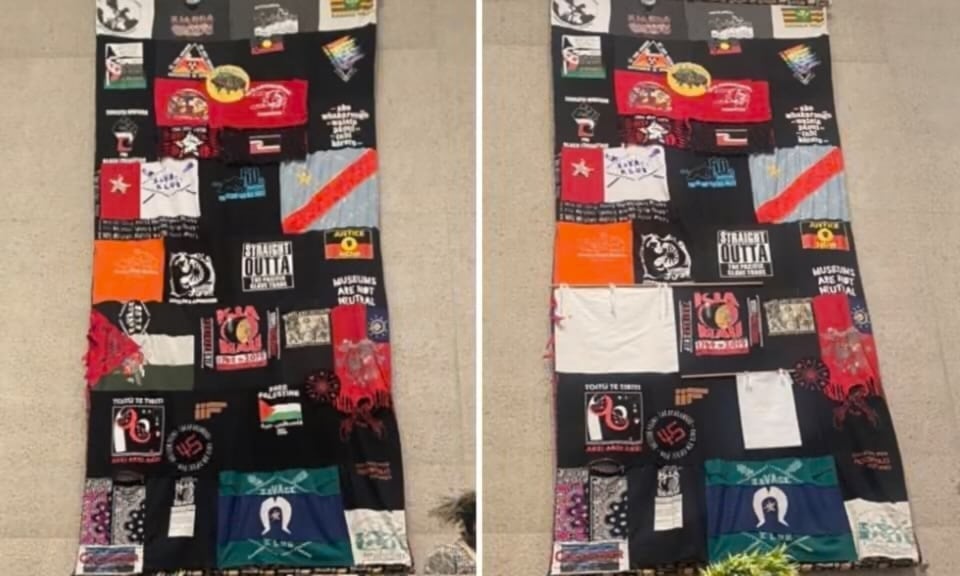NGA covers Palestinian flags after 'security assessment'
Critics call the National Gallery of Australia's decision a "disgraceful act of censorship" rooted in "political cowardice."
-

A tapestry from the SaVĀge K’lub Te Paepae Aora’i – Where the Gods Cannot be Fooled exhibition, where the Palestinian flag is visible (left) and then hidden (right). (Social media)
The National Gallery of Australia (NGA) said that it covered Palestinian flags in a major exhibition following a "security threat assessment," but critics argue that the decision was driven by "political cowardice."
The Guardian reported that two Palestinian flags on a large tapestry in the current exhibition in Canberra have been obscured with white fabric.
Rosanna Raymond, the exhibition's curator and founder of the Pacific Indigenous art collective SaVĀge K’lub in New Zealand, told The Guardian that the NGA censored the flags. Despite her efforts to resist, Raymond stated that she ultimately agreed to conceal the references to the Palestinian flag.
The Guardian initially reached out to the NGA on Monday after being notified about the altered artwork. The NGA declined to answer a series of detailed questions, and only provided a statement on Friday after the story became public.
Read next: Oracle’s TikTok bid under fire for censoring pro-Palestine voices
It remains unclear why the NGA decided to cover the flags 10 days after the artwork was installed or whether the gallery was responding to a specific threat or complaint. However, a spokesperson stated that the decision was made due to the risk posed by "sensitive content."
"We acknowledge the SaVĀge K’lub artists were placed in a difficult position and we are grateful for their willingness to collaborate with us in a challenging and uncertain environment," the spokesperson said.
"The National Gallery assessed the risks and determined what we believed was the most appropriate action, in consultation with curator Rosanna Raymond MNZM and the SaVĀge K’lub artists."
The large tapestry is part of the Te Paepae Aora’i – Where the Gods Cannot be Fooled exhibition, a group show by the Pacific Indigenous art collective SaVĀge K’lub.
Unjust censorship
The report highlighted that Penelope Benton, the executive director of the National Association for the Visual Arts, emphasized that the right to artistic expression is essential, and any intervention that changes an artwork's meaning must be thoroughly examined.
"Covering elements of an artwork not only risks undermining the integrity of the artists’ message but also raises serious concerns about the pressures institutions face in balancing artistic freedom with external influences," she said.
Nasser Mashni, the head of the Australian Palestine Advocacy Network, said that the decision was part of a larger effort to suppress those who advocate for Palestinian rights, rejecting the notion that the Palestinian flag posed a security risk.
"The NGA’s decision to police and erase Palestinian identity – by covering Palestinian flags in an artwork about social justice – is nothing less than a disgraceful act of censorship … rooted in political cowardice," he said.
Concern has been mounting within both the arts and Palestinian community in Australia after a week of anger generated by a decision by Creative Australia’s to walk back on the appointment of Lebanese-Australian artist Khaled Sabsabi, and curator Michael Dagostino, for the 2026 Venice Biennale.
Richard Bell, the Brisbane-based artist and co-founder of the Aboriginal art collective ProppaNOW, described the concealment of Palestinian flags and the dismissal of Sabsabi as a damning indictment of artistic freedom.
He said, "It’s horrifying, everyone is horrified at the moment. This is censorship, what is happening is absolutely censorship," adding, "What on earth are they thinking?"
Several of Bell's works are displayed in the NGA, including his 2020 piece The Truth Hurts, created during the Black Lives Matter protest, which features the words "WHITE LIES MATTER" on a colored canvas.
Reflecting on the outpouring of support for Sabsabi within the artistic community, Bell noted that he had never witnessed such unity in the Australian art scene.

 4 Min Read
4 Min Read








